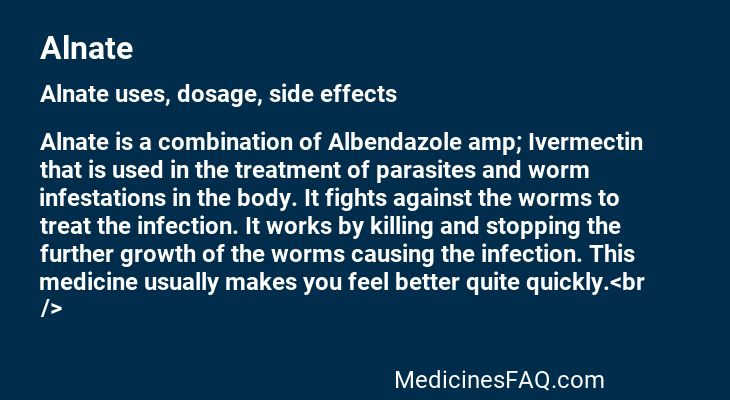Alnate
Alnate Uses, Dosage, Side Effects, Food Interaction and all others data.
Administration of ivermectin with albendazole is safe and more effective against Onchocerca volvulus than ivermectin alone, and whether a significant pharmacokinetic interaction occurs. Forty-two male onchocerciasis patients received ivermectin (200 mug/kg) alone, albendazole (400 mg) alone or the combination. Safety was determined from the results of detailed clinical and laboratory examinations before treatment, during hospitalization and on day 30.
The co-administration of ivermectin with albendazole did not produce more severe adverse effects than ivermectin alone. Both nodule examiners found that the combination was not macrofilaricidal and that it was not clearly superior to ivermectin alone in the effects on reproductive activity. This was supported by the similar efficacy of the two regimens in the suppression of skin microfilariae.
Ivermectin is an antiparasitic, which you usually only need to take once to get rid of your infection. Treats infections caused by worms and parasites.
Albendazole is effective for treating tapeworm infections, but may cause serious liver, blood, and eye problems.
| Trade Name | Alnate |
| Generic | Albendazole + Ivermectin |
| Weight | 200mg |
| Type | Tablet |
| Therapeutic Class | |
| Manufacturer | Shatayushi Healthcare Pvt Ltd |
| Available Country | India |
| Last Updated: | September 19, 2023 at 7:00 am |

Uses
Alnate is a combination of Albendazole & Ivermectin that is used in the treatment of parasites and worm infestations in the body. It fights against the worms to treat the infection. It works by killing and stopping the further growth of the worms causing the infection. This medicine usually makes you feel better quite quickly.
Alnate is also used to associated treatment for these conditions: Ascariasis, Hookworm Infection, Hydatid disease caused by Echinococcus granulosus, Neurocysticercosis caused by Taenia solium, Other specified protozoal diseasesAcne Rosacea, Ascaris lumbricoides infection, Cutaneous larva migrans, Demodicidosis, Gnathostomiasis, Mansonella ozzardi infection, Mansonella streptocerca infection, Oesophagostomiasis, Onchocerciasis, Pediculosis Capitis, Scabies, Trichuriasis, Wuchereria bancroftii infection
How Alnate works
Albendazole causes degenerative alterations in the tegument and intestinal cells of the worm by diminishing its energy production, ultimately leading to immobilization and death of the parasite. It works by binding to the colchicine-sensitive site of tubulin, thus inhibiting its polymerization or assembly into microtubules. As cytoplasmic microtubules are critical in promoting glucose uptake in larval and adult stages of the susceptible parasites, the glycogen stores of the parasites are depleted. Degenerative changes in the endoplasmic reticulum, the mitochondria of the germinal layer, and the subsequent release of lysosomes result in decreased production of adenosine triphosphate (ATP), which is the energy required for the survival of the helminth.
Ivermectin binds selectively and with high affinity to glutamate-gated chloride ion channels in invertebrate muscle and nerve cells of the microfilaria. This binding causes an increase in the permeability of the cell membrane to chloride ions and results in hyperpolarization of the cell, leading to paralysis and death of the parasite. Ivermectin also is believed to act as an agonist of the neurotransmitter gamma-aminobutyric acid (GABA), thereby disrupting GABA-mediated central nervous system (CNS) neurosynaptic transmission. Ivermectin may also impair normal intrauterine development of O. volvulus microfilariae and may inhibit their release from the uteri of gravid female worms.
Dosage
Alnate dosage
To keep animal free from helminths animal should be treated at 3 months interval.
Cattle & Buffalo: 7.5-10 mg/kg body weight or 14 bolus for 30-40 kg body weight, 12 bolus for 60-80 kg body weight & 1 boli for 120-160 kg body weight.
Goat & Sheep: 5-7.5 mg/kg body weight or 112 bolus for 13-20 kg body weight & 1 6 bolus for 27-40 kg body weight.
Dog & Cat: 15 mg/kg body weight or 18 bolus for 8-10 kg body weight & 14 bolus for 16-20 kg body weight.
Or as directed by the registered Veterinarian.
Oral
Filariasis:
- Adult: Dosing regimen depends on the causative agent. Mansonella streptocerca 150 mcg/kg as a single dose; Mansonella ozzardi 200 mcg/kg as a single dose.
- Child: ≥15 kg: Dosing regimen depends on the causative agent. Mansonella streptocerca 150 mcg/kg as a single dose; Mansonella ozzardi 200 mcg/kg as a single dose.
Scabies:
- Adult: Sarcoptes scabiei 200 mcg/kg as a single dose, repeat dose in 2 wk.
- Child: ≥15 kg: Sarcoptes scabiei 200 mcg/kg as a single dose, repeat dose in 2 wk.
Onchocerciasis:
- Adult:150 mcg/kg as a single dose; retreatment may be given every 6-12 mth until adult worms die.
- Child: >5 yr and ≥15kg: 150 mcg/kg as a single dose every 6-12 mth until adult worms die.
Ascariasis:
- Adult: Ascaris lumbricoides 150-200 mcg/kg as a single dose.
- Child: ≥15 kg: Ascaris lumbricoides 150-200 mcg/kg as a single dose.
Strongyloidiasis:
- Adult: 200 mcg/kg as a single dose for 1-2 days.
- Child: >15 kg: 200 mcg/kg as a single dose for 1-2 days.
Gnathostomiasis:
- Adult: Gnathostoma spinigerum: 200 mcg/kg once daily for 2 days.
- Child: ≥15 kg: Gnathostoma spinigerum: 200 mcg/kg once daily for 2 days.
Should be taken on an empty stomach.
Side Effects
Alnate may cause side effects. Tell your doctor if any of these symptoms are severe or do not go away:
- dizziness
- loss of appetite
- nausea
- vomiting
- stomach pain or bloating
- diarrhea
- constipation
- weakness
- sleepiness
- uncontrollable shaking of a part of the body
- chest discomfort
Toxicity
Symptoms of overdose include elevated liver enzymes, headaches, hair loss, low levels of white blood cells (neutropenia), fever, and itching.
LD50 = 29.5 mg/kg (Mouse, oral). LD50 = 10 mg/kg (Rat, oral). Adverse effects include muscle or joint pain, dizziness, fever, headache, skin rash, fast heartbeat.
Precaution
The co-administration of ivermectin with albendazole did not produce more severe adverse effects than ivermectin alone. Both nodule examiners found that the combination was not macrofilaricidal and that it was not clearly superior to ivermectin alone in the effects on reproductive activity. This was supported by the similar efficacy of the two regimens in the suppression of skin microfilariae.
Interaction
There was no significant pharmacokinetic interaction.
Volume of Distribution
The volume of distribution is 3 to 3.5 L/kg and it does not cross the blood-brain barrier.
Elimination Route
Poorly absorbed from the gastrointestinal tract due to its low aqueous solubility. Oral bioavailability appears to be enhanced when coadministered with a fatty meal (estimated fat content 40 g)
Moderately well absorbed. Improved absorption with high fat meal.
Half Life
Terminal elimination half-life ranges from 8 to 12 hours (single dose, 400mg).
16 hours (also reported at 22-28 hours)
Elimination Route
Albendazole is rapidly converted in the liver to the primary metabolite, albendazole sulfoxide, which is further metabolized to albendazole sulfone and other primary oxidative metabolites that have been identified in human urine. Urinary excretion of albendazole sulfoxide is a minor elimination pathway with less than 1% of the dose recovered in the urine. Biliary elimination presumably accounts for a portion of the elimination as evidenced by biliary concentrations of albendazole sulfoxide similar to those achieved in plasma.
Ivermectin is metabolized in the liver, and ivermectin and/or its metabolites are excreted almost exclusively in the feces over an estimated 12 days, with less than 1% of the administered dose excreted in the urine.
Pregnancy & Breastfeeding use
Albendazole are well tolerated, with no adverse events in pregnant women and their fetuses when given after the first trimester of pregnancy. Anthelminthic medicines must not be given during the first trimester.
Ivermectin has been assigned to pregnancy category C by the FDA. Animal studies have revealed evidence of teratogenicity, but at doses that were also maternotoxic to the pregnant female. The manufacturer considers ivermectin contraindicated during pregnancy.
Alnate is probably safe to use during breastfeeding. Limited human data suggests that the drug does not represent any significant risk to the baby.
Contraindication
This is known to be teratogenic and embryo-toxic in some animals. Therefore it should not be administered during pregnancy or in women thought to be pregnant. It should only be used in the treatment of echinococcosis if there is constant medical supervision with regular monitoring of serumtransaminase concentrations and of leucocyte and platelet counts.
Hypersensitivity. Pregnancy and lactation. Children <15 kg body weight.
Acute Overdose
If poisoning or excessive overdosageis suspected, it is recommended for vomiting be induction or gastric lavage and such symptomatic supportive therapy to be administered.
Storage Condition
Do not store above 30 degree centigrade. Keep away from light and out of the reach of children.
Store below 30°C.
Innovators Monograph
You find simplified version here Alnate
FAQ
How does Alnate work?
Alnate is a combination of two antiparasitic medicines: Ivermectin and Albendazole. Ivermectin works by binding to muscle and nerve cells of worms causing their paralysis and death. Albendazole works by keeping the worms from absorbing sugar (glucose), so that they lose energy and die. This treats your infection effectively.
What are the side effects of Alnate?
Some of the side-effects that may be associated with Alnate include skin rash, nausea, vomiting, diarrhea, stomach pain, facial or limb swelling, neurologic adverse events (dizziness, seizures, confusion), sudden drop in blood pressure, severe skin rash potentially requiring hospitalization and liver injury.
Is Alnate safe?
Although the co-administration of ivermectin with albendazole appears safe, it offers no advantage over ivermectin alone in the control of onchocerciasis. The combination does not require an alteration in the dosage of either component.
What is the use of Alnate?
Alnate is used to treat worms or parasitic infections. Both are in the category of antiparasitic drug.







